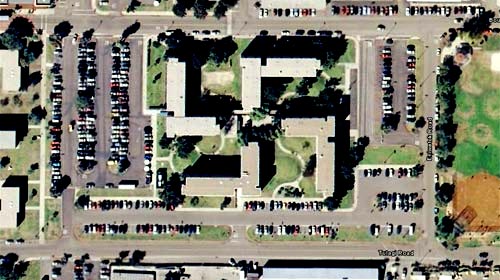
The image above was taken from Google Earth and shows the barracks at the U.S. Naval base in Corronado, California. Aparently the buildings are lovely from the ground, but from the air they’re, uh, offensive. The Navy is planning to spend “$600,000 for landscaping and architectural modifications” to alter the way the barracks look from the air.
What I find interesting about this story is that Google Earth “created” this problem for the Navy. The technology literally allowed people to see this symbol. It reminded me of this passage from Jorge Luis Borges’s “The Aleph”:
The Aleph's diameter was probably little more than an inch, but all space was there, actual and undiminished. Each thing (a mirror's face, let us say) was infinite things, since I distinctly saw it from every angle of the universe. I saw the teeming sea; I saw daybreak and nightfall; I saw the multitudes of America; I saw a silvery cobweb in the center of a black pyramid; I saw a splintered labyrinth (it was London); I saw, close up, unending eyes watching themselves in me as in a mirror; I saw all the mirrors on earth and none of them reflected me; I saw in a backyard of Soler Street the same tiles that thirty years before I'd seen in the entrance of a house in Fray Bentos; I saw bunches of grapes, snow, tobacco, lodes of metal, steam; I saw convex equatorial deserts and each one of their grains of sand; I saw a woman in Inverness whom I shall never forget; I saw her tangled hair, her tall figure, I saw the cancer in her breast; I saw a ring of baked mud in a sidewalk, where before there had been a tree; I saw a summer house in Adrogué and a copy of the first English translation of Pliny—Philemon Holland's—and all at the same time saw each letter on each page (as a boy, I used to marvel that the letters in a closed book did not get scrambled and lost overnight); I saw a sunset in Querétaro that seemed to reflect the colour of a rose in Bengal; I saw my empty bedroom; I saw in a closet in Alkmaar a terrestrial globe between two mirrors that multiplied it endlessly; I saw horses with flowing manes on a shore of the Caspian Sea at dawn; I saw the delicate bone structure of a hand; I saw the survivors of a battle sending out picture postcards; I saw in a showcase in Mirzapur a pack of Spanish playing cards; I saw the slanting shadows of ferns on a greenhouse floor; I saw tigers, pistons, bison, tides, and armies; I saw all the ants on the planet; I saw a Persian astrolabe; I saw in the drawer of a writing table (and the handwriting made me tremble) unbelievable, obscene, detailed letters, which Beatriz had written to Carlos Argentino; I saw a monument I worshipped in the Chacarita cemetery; I saw the rotted dust and bones that had once deliciously been Beatriz Viterbo; I saw the circulation of my own dark blood; I saw the coupling of love and the modification of death; I saw the Aleph from every point and angle, and in the Aleph I saw the earth and in the earth the Aleph and in the Aleph the earth; I saw my own face and my own bowels; I saw your face; and I felt dizzy and wept, for my eyes had seen that secret and conjectured object whose name is common to all men but which no man has looked upon—the unimaginable universe.
What fascinates me about this passage is that what the protaganist can “see” is limited (from our contemporary point of view) by the technology avaliable to him. While some technological developments like word processing aren’t represented by the list—he can see a book and all the letters in it—one could make the argument that he is limited because that technology doesn’t exist in the timeframe of the story. However, the speaker only sees what eyes can see—people, places, the insides of bodies, all are from the perspective given by the unaided eye. With our x-rays, telescopes, and satelites, what would an Aleph see now?
Comments
Other Swastikas on Google Earth
Here is other "Swastikas" on Google Earth : http://www.geo-trotter.com/cat-swastika.php